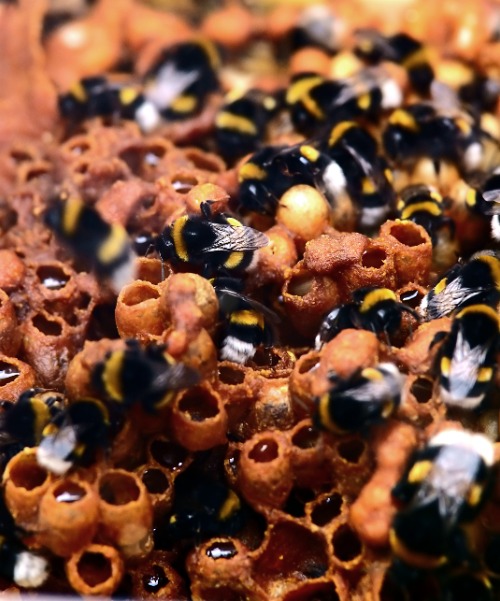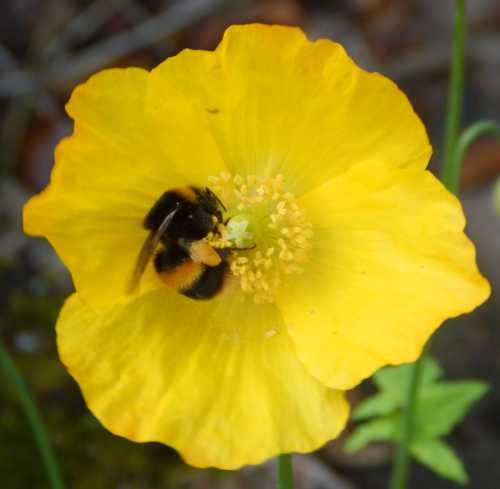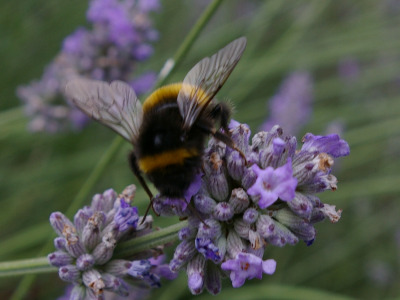Bumble Bee Eggs
Like other types of bees, bumble bees lay eggs.
If you have ever wondered what they look like, or why some develop into queens, workers or males, read on and watch these videos!
Frequently asked questions about bumble bee eggs are answered below.
FAQS About Bumble Bee Eggs
Once a bumble bee queen has located a suitable nest site, she begins making wax pots and gathering food to sustain herself and to feed her offspring.
Once she is ready, she begins to lay eggs.
These eggs hatch into small, grub-like larvae that feed and eventually spin a silky cocoon where the grub pupates, before emerging as an adult bumble bee.
 Inside the nest of the White-tailed Bumble Bee - Bombus lucorum showing nectar cups and cocoons
Inside the nest of the White-tailed Bumble Bee - Bombus lucorum showing nectar cups and cocoonsWhat do bumble bee eggs look like and how large are they?
Bumble bee eggs look like a small curved grain of rice measuring 2 - 4 mm.
As such, they are around the size of a honey bee egg - and of similar appearance, but much smaller than the egg of a carpenter bee (Xylocopa genus).
Watch this excellent short video of a bumble bee queen laying an egg in a wax 'egg cup'.
Where do bumble bees lay their eggs?
Queens lay their eggs:
- either in a wax egg cup provisioned with food, or
- in a 'brood clump' inside their nests.
A brood clump is a mixture of pollen and nectar with a batch of eggs inside, and surrounded by a layer of wax1.
When the eggs hatch, the larvae will eat the food stores.
Below is a further excellent video of a bumble bee queen sealing up an egg cup in which she has laid her eggs.
Caste determination:
What is the difference between eggs from which queens, workers and males develop?
Queens and workers
Queens and workers (females) develop from fertilized eggs - that is, eggs fertilized by male sperm stored in the queen's spermatheca2.
However, theories about what then determines a queen versus a worker bumble bee have been debated over the years.
Goulson1 notes that past theories related to larval feeding of food (for example, suggestions that larvae which are fed a certain diet or are fed greater quantities of food will develop into queens) are largely unsubstantiated.
Instead, Goulson suggests it is generally accepted that for Bombus terrestris (Buff-tailed Bumble Bee) at least, caste determination occurs during 2 critical phases of larval development:
- At around 2 -5 days into their development, the queen secretes a pheromone over the larvae.
- The presence of the pheromone instigates development into a worker.
- The absence of the pheromone will result in the larva developing into a queen.
Which eggs are reared first?
Once she has located a suitable site for a nest, the queen will begin rearing workers.
Later, she will rear males and new queens (called 'gynes').
How many eggs do bumble bees lay?
Bumble bee colonies vary in size, depending on species and environment.
For example, in a larger colony, around 400 eggs will develop into fully grown adult bees.
In smaller colonies, there may be as few as 20 eggs that will develop into fully grown adults.
It's possible that more eggs are laid than actually develop into adult bees. Eggs could be destroyed by predators, or even by other members of the colony.
You can read more about this on my page: How many bumble bees are there in a colony?
Can bumble bee workers lay eggs?
Bumble bee workers may also lay eggs, and in this respect, they compete with the queen to produce offspring.
This stage in the colony life cycle is termed 'the competition point'3.
This activity has been observed in Bombus terrestris colonies, where dominant egg-laying workers may play a role in inhibiting the production of eggs by younger workers3.
Researchers have found that among Bombus terrestris workers, there is a direct relationship between worker dominance and ovary size, whereby bees with larger ovaries are more dominant than those with smaller ovaries3.
Interestingly, it has also been shown that the presence of other workers speeds the development of eggs3.
The eggs of worker bumble bees may be destroyed, either by the queen, or by other workers. During the competition phase the queen may eat the eggs of workers and vice versa1.
According to one study, eggs laid by workers were slightly smaller than those raised by queens4.
How long does it take for eggs to develop into bees?
Eggs hatch and larvae emerge. Larvae feed, then create a silken cocoon where they will pupate and continue their development before adult bees finally emerge.
Development from egg to adult takes about 2 - 3 weeks.
References
1. Goulson, D. 2010. Bumblebees, behavior and ecology. Oxford Univ. Press, Oxford, U.K
2. Guo Y, Zhang Q, Hu X, Pang C, Li J and Huang J (2021) Mating Stimulates the Immune Response and Sperm Storage-Related Genes Expression in Spermathecae of Bumblebee (Bombus terrestris) Queen. Front. Genet. 12:795669. doi: 10.3389/fgene.2021.795669
3. Cnaani, Jonathan & Wong, Andy & Thomson, James. (2007). Effect of group size on ovarian development in bumblebee workers (Hymenoptera: Apidae: Bombus). Entomologia Generalis. 29. 305-314.
4. Zamoscik, Vera. (2007). Chemical recognition signals on the surface of eggs of the bumblebee Bombus terrestris (Hymenoptera: Apidae). 10.13140/RG.2.2.12527.94880.

